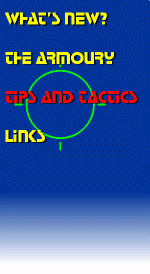 |
TIPS AND TACTICS
How does one get the most out of their waterguns? How to you avoid
being drenched with water while keeping your foes at bay? Read on to find
out...
Tips for CPS Usage
CARE AND MAINTAINANCE: When
preparing for combat, make sure the shoulder strap is the right length
for oneself. As well, only use clean tap water to prevent the gun from
gumming up with gunk. Due to the strength of the water streams, fine particulates
in the water can result in injury, especially if it gets into another's
eyes. These weapons are meant to soak people, not maim them. If the weapon
feels awkward or too heavy, it may be recommended to go for a lower class
weapon. A heavy firing water cannon is not too useful to one who cannot
aim or maneuver well with it.
When the battle is over, as Larami Limited suggests, definitely empty all
water and depressurize the weapons when not in use. This prevents the build
up of "buggies" (i.e. mildew) as well as prolongs the life of
the CPS firing mechanism. Most CPS models can be drained by pulling the
trigger, then continuing to pump while the trigger is depressed to empty
the tubes within the recesses of the gun. Thanks to the cap design on all
except for the CPS 2000, the caps can be left unscrewed and hanging to
allow the main tank to dry. The weapons should be stored in a cool, dry
place away from direct sunlight to prevent the weapons from warping. (They're
only plastic, y'know.) It is also recommendable to do a couple of dry shots
to try and empty any remaining water from the CPS firing chamber.
MAXIMIZING USE: Since all CPS weapons
have a separate pressurized firing chamber versus the water resevoir, one
way to get an extra shot is to fill the tank first, pump to fill the firing
chamber, then top off the tank. This will give one extra full burst, a
definite plus especially considering how fast one can empty the gun due
to their increased firing rate.
(Cheap Trick: If one is almost out of water and is being pursued, one can
fill the firing chamber with water, then unscrew the resevoir's cap and
shake the gun upside-down as if to say that one is out of ammo. If one's
foes are a little too presumptuous, they will approach you without fear
which is when you can, surprise, unleash a full burst of water onto them.
Unfortunately, this trick usually does not work for veteran water warriors
or those who have already seen it done.)
MINIMIZING WASTE: Though simple
to do, one should avoid emptying the entire firing chamber of your CPS
weapon in one long shot. Short bursts tend to be more effective at drenching
a moving target. As well, short bursts conserve water consumption hence
increase the duration one may remain on the field before returning to base
to refill. Of course, in certain situations, a full payload shot may be
worth the price in water, but for the most part, should be avoided.
NOZZLE KNOWLEDGE: If the CPS you
are using is one with more than one nozzle setting, one should be familiar
with the advantage of each. Larger nozzles can soak a foe faster, but also
drains one's resourses equally as quick. If the weapon is one's own, one
may consider writing numbers on the top of each nozzle such that one does
not need to look at the front of the gun, only at the top, to know what
nozzle it is set at. A good, black, waterproof marker works best for labelling.
(For the CPS 2500, it is probably best to write on the outer part which
rotates as one switches nozzle settings as this area is more clearly visible
when holding the weapon as opposed to the nozzles themselves.)
|